7 Habits of Highly Effective People Negative Review
![Download Now: How to Be More Productive at Work [Free Guide + Templates]](https://no-cache.hubspot.com/cta/default/53/5ab914ce-204e-40ef-acfe-d7bfec642e1a.png)
What habits do highly effective people take?
The volume opens with an explanation of how many individuals who accept achieved a loftier degree of outward success however find themselves struggling with an inner need for developing personal effectiveness and growing healthy relationships with other people.
Covey believes the way we come across the world is entirely based on our own perceptions. In club to change a given situation, we must modify ourselves, and in order to change ourselves, we must be able to change our perceptions.
In studying over 200 years of literature on the concept of "success," Covey identified a very of import change in the way that humans have defined success over time.
In before times, the foundation of success rested upon grapheme ethic (things like integrity, humility, fidelity, temperance, courage, justice, patience, industry, simplicity, modesty, and the Gilded Rule). Only starting around the 1920s, the manner people viewed success shifted to what Covey calls "personality ethic" (where success is a function of personality, public image, attitudes, and behaviors).

These days, people look for quick fixes. They run into a successful person, team, or system and ask, "How practise you do information technology? Teach me your techniques!" But these "shortcuts" that we look for, hoping to save time and effort and still reach the desired result, are simply band-aids that will yield short-term solutions. They don't address the underlying condition.
"The way we come across the problem is the problem," Covey writes. We must let ourselves to undergo paradigm shifts — to change ourselves fundamentally and not just change our attitudes and behaviors on the surface level — in order to achieve truthful change.
That's where the seven habits of highly effective people come in:
- Habits 1, 2, and 3 are focused on self-mastery and moving from dependence to independence.
- Habits iv, 5, and 6 are focused on developing teamwork, collaboration, and communication skills, and moving from independence to interdependence.
- Habit 7 is focused on continuous growth and improvement and embodies all the other habits.
Permit's dive into the 7 habits, at present — keep reading, or click on a specific habit to jump correct to that section.
7 Habits of Highly Effective People
i. Be Proactive
two. Begin with the Finish in Mind
3. Put First Things Get-go
4. Think Win-Win
5. Seek Outset to Understand, Then to Be Understood
6. Synergize
7. Acuminate the Saw
1. Exist Proactive
Quick Summary:
Nosotros're in charge. We choose the scripts by which to live our lives. Use this self-awareness to be proactive and have responsibility for your choices.
The starting time habit that Covey discusses is beingness proactive. What distinguishes the states equally humans from all other animals is our inherent ability to examine our ain grapheme, to decide how to view ourselves and our situations, and to command our own effectiveness.
Put only, in gild to be effective ane must be proactive.
Reactive people take a passive stance — they believe the world is happening to them. They say things like:
- "In that location'southward nothing I tin can do."
- "That's just the fashion I am."
They recall the problem is "out at that place" — but that thought is the problem. Reactivity becomes a cocky-fulfilling prophecy, and reactive people feel increasingly victimized and out of command.
Proactive people, however, recognize they have responsibleness — or "response-ability," which Covey defines every bit the power to choose how you lot will respond to a given stimulus or situation.
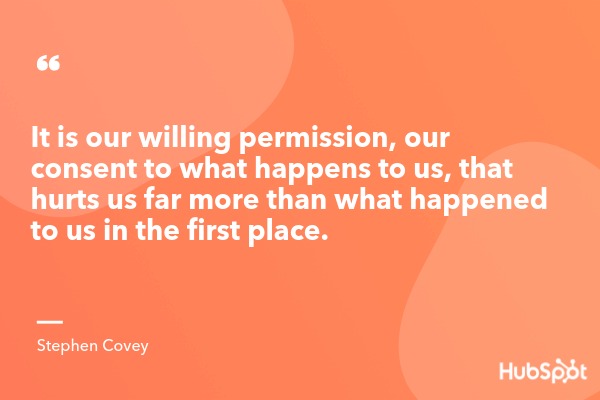
In social club to be proactive, we must focus on the Circumvolve of Influence that lies inside our Circle of Concern— in other words, we must work on the things we can do something near.

The positive energy we exert will crusade our Circle of Influence to expand.
Reactive people, on the other hand, focus on things that are in their Circle of Concern but not in their Circle of Influence, which leads to blaming external factors, emanating negative energy, and causing their Circumvolve of Influence to shrink.
Key Lessons:
Challenge yourself to test the principle of proactivity by doing the following:
i. Beginning replacing reactive linguistic communication with proactive linguistic communication.
Reactive = "He makes me so mad." Proactive = "I control my ain feelings."
2. Convert reactive tasks into proactive ones.
2. Begin with the End in Mind
Quick Summary:
Get-go with a clear destination in listen. Covey says we can use our imagination to develop a vision of what nosotros want to become and use our censor to decide what values will guide u.s.a..
Most of us observe information technology rather easy to busy ourselves. We work difficult to achieve victories — promotions, higher income, more recognition. But we don't ofttimes stop to evaluate the meaning backside this busyness, behind these victories — we don't ask ourselves if these things that we focus on so intently are what really thing to the states.
Habit 2 suggests that, in everything nosotros do, we should brainstorm with the end in mind. Start with a articulate destination. That way, we can make sure the steps we're taking are in the right direction.
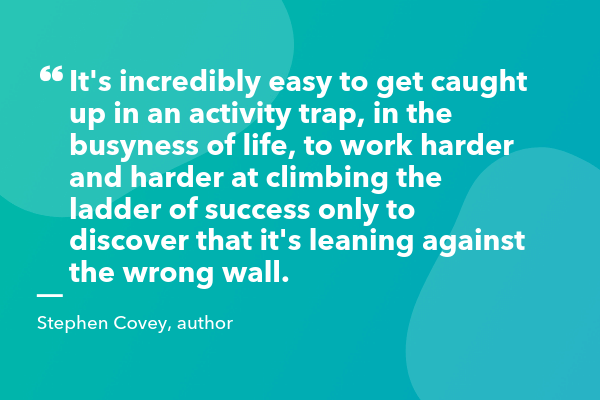
Covey emphasizes that our self-awareness empowers us to shape our own lives, instead of living our lives by default or based on the standards or preferences of others.
Beginning with the finish in mind is too extremely of import for businesses. Being a manager is virtually optimizing for efficiency. But being a leader is about setting the correct strategic vision for your organization in the first place, and asking, "What are nosotros trying to reach?"
Before we equally individuals or organizations can start setting and achieving goals, we must exist able to identify our values. This process may involve some rescripting to be able to assert our own personal values.
Rescripting, Covey explains, is recognizing ineffective scripts that have been written for you lot, and changing those scripts by proactively writing new ones that are congenital of your own values.
Information technology is also important to identify our center. Any is at the center of our life volition be the source of our security, guidance, wisdom, and ability.

Our centers affect us fundamentally — they determine our daily decisions, actions, and motivations, as well as our interpretation of events.
However, Covey notes that none of these centers are optimal and that instead, nosotros should strive to be principle-centered. We should identify the timeless, unchanging principles by which we must live our lives. This will give u.s.a. the guidance that we need to align our behaviors with our beliefs and values.
Cardinal Lessons:
Challenge yourself to test the principle of kickoff with the end in mind past doing the following:
1. Visualize in rich detail your own funeral. Who is there? What are they saying almost you? About how you lived your life? Most the relationships you had? What do y'all want them to say? Think about how your priorities would alter if you only had 30 more than days to live. Start living by these priorities.
ii. Break down unlike roles in your life — whether professional person, personal, or community — and list iii to 5 goals y'all want to reach for each.
three. Define what scares you. Public speaking? Critical feedback after writing a volume? Write down the worst-case scenario for your biggest fear, then visualize how you'll handle this situation. Write down exactly how yous'll handle information technology.
three. Put Showtime Things First
Quick Summary:
In gild to manage ourselves effectively, we must put outset things beginning. We must accept the discipline to prioritize our solar day-to-day deportment based on what is well-nigh important, not what is most urgent.
In Habit ii, we discussed the importance of determining our values and understanding what it is nosotros are setting out to achieve. Habit 3 is about really going afterward these goals, and executing on our priorities on a day-to-day, moment-to-moment basis.
In order to maintain the discipline and the focus to stay on track toward our goals, we need to accept the willpower to exercise something when we don't want to do it. Nosotros need to act according to our values rather than our desires or impulses at whatsoever given moment.
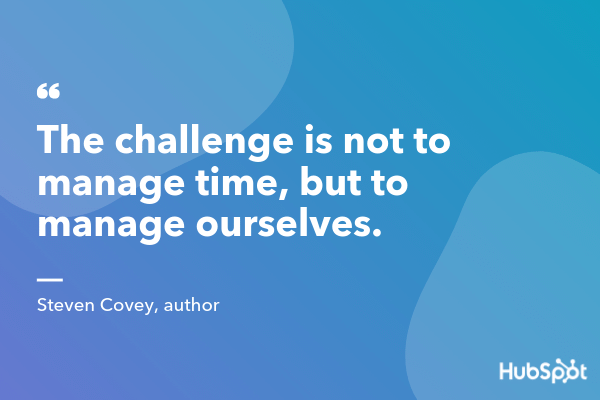
All activities can be categorized based on 2 factors: Urgent and important. Have a look at this time direction matrix:

We react to urgent matters. We spend our fourth dimension doing things that are not important. That means that we fail Quadrant 2, which is the actually most crucial of them all.
If we focus on Quadrant I and spend our time managing crises and problems, it keeps getting bigger and bigger until it consumes the states. This leads to stress, exhaustion, and constantly putting out fires.
If nosotros focus on Quadrant 3, we spend most of our fourth dimension reacting to matters that seem urgent, when the reality is their perceived urgency is based on the priorities and expectations of others. This leads to curt-term focus, feeling out of control, and shallow or broken relationships.
If we focus on Quadrant IV, we are basically leading an irresponsible life. This often leads to getting fired from jobs and being highly dependent on others.
Quadrant 2 is at the heart of effective personal management. Information technology deals with things like building relationships, long-term planning, exercising, grooming — all things we know we demand to do merely somehow seldom get around to actually doing because they don't experience urgent.
In club to focus our fourth dimension in Quadrant II, nosotros have to learn how to say "no" to other activities, sometimes ones that seem urgent. We besides need to be able to consul finer.
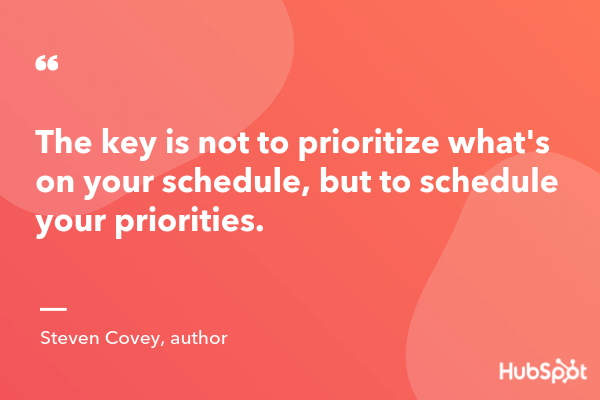
Plus, when nosotros focus on Quadrant 2, it ways we're thinking ahead, working on the roots, and preventing crises from happening in the outset place! This helps us implement the Pareto Principle — eighty% of your results come from xx% of your time.
We should e'er maintain a primary focus on relationships and results, and a secondary focus on fourth dimension.
"Think effectiveness with people and efficiency with things." —Stephen Covey
Key Lessons:
Here are some ways you lot tin practice putting beginning things first:
1. Identify a Quadrant Ii activeness y'all've been neglecting. Write information technology down and commit to implementing it.
ii. Create your ain time management matrix to start prioritizing.
3. Gauge how much fourth dimension y'all spend in each quadrant. Then log your fourth dimension over 3 days. How accurate was your gauge? How much time did you spend in Quadrant Ii (the almost of import quadrant)?
iv. Recall Win-Win
Quick Summary:
In order to plant effective interdependent relationships, we must commit to creating Win-Win situations that are mutually beneficial and satisfying to each party.
Covey explains that at that place are half-dozen paradigms of human interaction:
i. Win-Win: Both people win. Agreements or solutions are mutually beneficial and satisfying to both parties.
2. Win-Lose: "If I win, you lose." Win-Lose people are prone to apply position, ability, credentials, and personality to get their manner.
3. Lose-Win: "I lose, you win." Lose-Win people are quick to please and appease, and seek strength from popularity or acceptance.
4. Lose-Lose: Both people lose. When two Win-Lose people get together — that is, when two, determined, stubborn, ego-invested individuals collaborate — the outcome will exist Lose-Lose.
5. Win: People with the Win mentality don't necessarily want someone else to lose — that's irrelevant. What matters is that they get what they desire.
vi. Win-Win or No Deal: If you tin't attain an agreement that is mutually benign, there is no deal.
The best pick is to create Win-Win situations. With Win-Lose, or Lose-Win, i person appears to get what he wants for the moment, but the results volition negatively bear on the relationship betwixt those two people going frontwards.
The Win-Win or No Deal option is important to employ as a backup. When we have No Deal as an option in our mind, information technology liberates us from needing to dispense people and button our ain calendar. We can be open and actually attempt to sympathise the underlying issues.
In solving for Win-Win, we must consider two factors: Consideration and courage. Accept a wait at the following chart:

"To become for Win-Win, you not only have to exist dainty, you have to exist courageous." — Stephen Covey
Another of import gene in solving for Win-Win situations is maintaining an Abundance Mentality, or the belief that there's plenty out in that location for everyone.
Most people operate with the Scarcity Mentality — pregnant they deed as though everything is zero-sum (in other words, if you get it, I don't). People with the Scarcity Mentality have a very hard fourth dimension sharing recognition or credit and find information technology hard to be genuinely happy about other people's successes.
When information technology comes to interpersonal leadership, the more than 18-carat our character is, the higher our level of proactivity; the more committed we are to Win-Win, the more than powerful our influence will be.
To achieve Win-Win, go on the focus on results, not methods; on problems, not people.
Lastly, the spirit of Win-Win tin can't survive in an environment of contest. Every bit an arrangement, we demand to marshal our reward organization with our goals and values and have the systems in place to support Win-Win.
Key Lessons:
Get yourself to outset thinking Win-Win with these challenges:
1. Think virtually an upcoming interaction where you lot'll be attempting to accomplish an agreement or solution. Write down a list of what the other person is looking for. Next, write a list next to that of how yous tin make an offer to meet those needs.
2. Identify three important relationships in your life. Think virtually what you feel the residue is in each of those relationships. Exercise yous give more than y'all take? Accept more you lot give? Write downwards ten ways to ever give more than you lot have with each one.
three. Deeply consider your own interaction tendencies. Are they Win-Lose? How does that affect your interactions with others? Can yous identify the source of that approach? Determine whether or not this approach serves you well in your relationships. Write all of this downwards.
Email is i place we all apace build poor habits. Rather than wasting time by copying and pasting email templates that you apply every day, we recommend using HubSpot's free CRM to easily transport personalized email templates in Gmail and Outlook.
5. Seek First to Understand, So to Be Understood
Quick Summary:
Before nosotros can offering advice, suggest solutions, or effectively interact with another person in whatsoever way, nosotros must seek to deeply empathise them and their perspective through empathic listening.
Allow's say you become to an optometrist and tell him that you've been having trouble seeing clearly, and he takes off his glasses, hands them to you lot and says, "Hither, endeavor these — they've been working for me for years!" Yous put them on, but they just brand the problem worse. What are the chances you'd get back to that optometrist?
Unfortunately, we do the same thing in our everyday interactions with others. We prescribe a solution before nosotros diagnose the problem. We don't seek to deeply sympathize the problem first.
Habit five says that we must seek first to understand, then to be understood. In order to seek to understand, we must learn to listen.
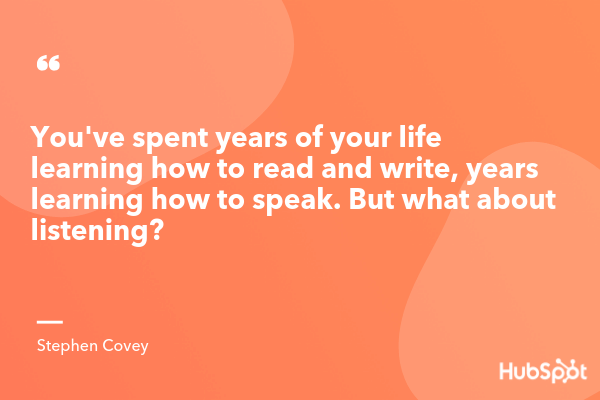
We can't simply utilise one technique to understand someone. In fact, if a person senses that we're manipulating her, she will question our motives and will no longer feel condom opening upwardly to usa.
"You have to build the skills of empathic listening on a base of operations of character that inspires openness and trust." — Stephen Covey
To mind empathically requires a fundamental image shift. We typically seek first to be understood. Nigh people listen with the intent to reply, non to sympathize. At whatsoever given moment, they're either speaking or preparing to speak.
After all, Covey points out, communication experts estimate that:
- 10% of our advice is represented by our words [CLICK TO TWEET]
- thirty% is represented by our sounds [CLICK TO TWEET]
- 60% is represented past our body linguistic communication [CLICK TO TWEET]
When we listen autobiographically — in other words, with our ain perspective as our frame of reference — we tend to reply in 1 of four ways:
i. Evaluate: Hold or disagree with what is said
2. Probe: Ask questions from our ain frame of reference
3. Advise: Give counsel based on our own experience
4. Interpret: Try to effigy out the person's motives and behavior based on our own motives and behavior
But if we replace these types of response with empathic listening, we meet dramatic results in improved advice. It takes time to make this shift, but it doesn't take well-nigh as long to practice empathic listening as information technology does to back up and correct misunderstandings, or to live with unexpressed and unresolved problems only to accept them surface subsequently on.
The second part of Habit 5 is " ... then to exist understood." This is as critical in achieving Win-Win solutions.
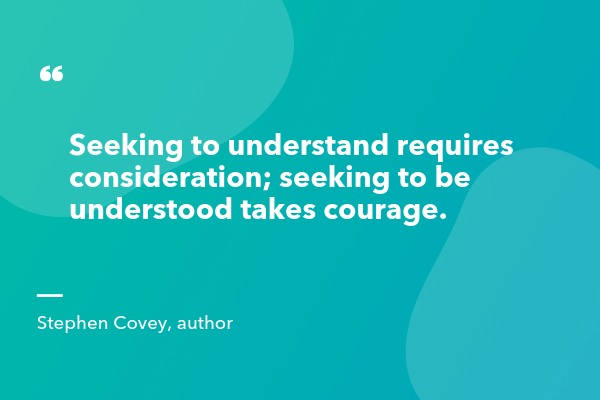
When we're able to nowadays our ideas clearly, and in the context of a deep agreement of the other person'southward needs and concerns, we significantly increase the credibility of your ideas.
Key Lessons:
Hither are a few ways to become yourself in the habit of seeking commencement to sympathize:
1. Adjacent time you're watching ii people communicating, comprehend your ears and watch. What emotions are beingness communicated that might non come across through words lone? Was one person or the other more interested in the conversation? Write down what you noticed.
two. Next time you requite a presentation, root information technology in empathy. Begin by describing the audience'southward point of view in great particular. What problems are they facing? How is what you're almost to say offering a solution to their problems?
six. Synergize
Quick Summary:
By understanding and valuing the differences in another person's perspective, nosotros accept the opportunity to create synergy, which allows us to uncover new possibilities through openness and inventiveness.
The combination of all the other habits prepares us for Habit 6, which is the addiction of synergy or "When one plus ane equals three or more and the whole is bang-up than the sum of its parts."
For example, if yous plant 2 plants close together, their roots will co-mingle and amend the quality of the soil, so that both plants will grow better than they would on their own.
Synergy allows us to create new alternatives and open up new possibilities. It allows u.s. as a group to collectively agree to ditch the one-time scripts and write new ones.
"Without dubiousness, yous take to exit the comfort zone of base camp and face an entirely new and unknown wilderness." —Stephen Covey
And so how can we introduce synergy to a given state of affairs or environment? Get-go with habits 4 and five — you must call back Win-Win and seek kickoff to sympathise.
One time you have these in mind, you tin pool your desires with those of the other person or group. And and so you lot're non on opposite sides of the problem — you're together on one side, looking at the problem, understanding all the needs, and working to create a tertiary alternative that will meet them.
What we terminate upwardly with is not a transaction, simply a transformation. Both sides go what they want, and they build their relationship in the process.
By putting forth a spirit of trust and safety, we will prompt others to become extremely open and feed on each other's insights and ideas, creating synergy.
The existent essence of synergy is valuing the differences — the mental, emotional, and psychological differences between people.
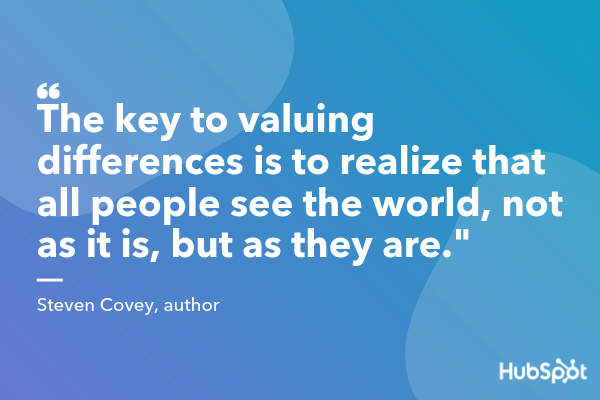
Afterwards all, if two people have the same opinion, i is unnecessary. When we become aware of someone'due south different perspective, we can say, "Expert! Yous see information technology differently! Help me meet what you see."
We seek commencement to understand, and then we find strength and utility in those dissimilar perspectives in order to create new possibilities and Win-Win results.
Synergy allows you to:
- Value the differences in other people equally a way to expand your perspective
- Sidestep negative free energy and look for the adept in others
- Exercise backbone in interdependent situations to exist open and encourage others to be open
- Catalyze creativity and notice a solution that volition be better for everyone past looking for a 3rd culling
Key Lessons:
1. Make a list of people who irritate yous. Now cull just one person. How are their views different? Put yourself in their shoes for one infinitesimal. Think and pretend how it feels to be them. Does this help you understand them better?
Now next time you're in a disagreement with that person, try to understand their concerns and why they disagree with you. The meliorate you can empathize them, the easier it volition exist to change their mind — or change yours.
2. Make a list of people with whom you lot get along well. At present choose only one person. How are their views dissimilar? At present write down a situation where you had splendid teamwork and synergy. Why? What conditions were met to accomplish such fluidity in your interactions? How tin yous recreate those conditions over again?
7. Sharpen the Saw
Quick Summary:
To exist effective, we must devote the fourth dimension to renewing ourselves physically, spiritually, mentally, and socially. Continuous renewal allows us to synergistically increase our power to practice each habit.
Habit 7 is focused around renewal, or taking time to "sharpen the saw." Information technology surrounds all of the other habits and makes each one possible by preserving and enhancing your greatest asset — yourself.
There are four dimensions of our nature, and each must be exercised regularly, and in balanced ways:
Concrete Dimension: The goal of continuous physical comeback is to exercise our torso in a way that will enhance our chapters to work, adapt, and relish.
To renew ourselves physically, we must:
- Eat well
- Become sufficient balance and relaxation
- Exercise on a regular ground to build endurance, flexibility, and strength
Focusing on the concrete dimension helps develop Addiction 1 muscles of proactivity. Nosotros human action based on the value of well-being instead of reacting to the forces that keep us from fitness.
Spiritual Dimension: The goal of renewing our spiritual self is to provide leadership to our life and reinforce your commitment to our value system.
To renew yourself spiritually, you can:
- Practice daily meditation
- Communicate with nature
- Immerse yourself in great literature or music
A focus on our spiritual dimension helps us practice Habit 2, as nosotros continuously revise and commit ourselves to our values, so we tin can begin with the finish in listen.
Mental Dimension: The goal of renewing our mental wellness is to continue expanding our mind.
To renew yourself mentally, you can:
- Read good literature
- Continue a periodical of your thoughts, experiences, and insights
- Limit television watching to simply those programs that enrich your life and mind
Focusing on our mental dimension helps usa practice Habit iii by managing ourselves effectively to maximize the use of our time and resource.
Social/Emotional Dimension: The goal of renewing ourselves socially is to develop meaningful relationships.
To renew yourself emotionally, y'all can:
- Seek to deeply empathise other people
- Brand contributions to meaningful projects that improve the lives of others
- Maintain an Affluence Mentality, and seek to assist others notice success
Renewing our social and emotional dimension helps united states of america practice Habits 4, 5, and vi by recognizing that Win-Win solutions do exist, seeking to empathise others, and finding mutually beneficial third alternatives through synergy.
"Not a twenty-four hours goes by that we can't at least serve one other homo being by making deposits of unconditional love." -Stephen Covey
As nosotros focus on renewing ourselves along these four dimensions, we must too seek to be a positive scripter for other people. Nosotros must look to inspire others to a higher path past showing them we believe in them, by listening to them empathically, by encouraging them to be proactive.
The existent dazzler of the 7 Habits is that improvement in one habit synergistically increases our ability to ameliorate the rest.
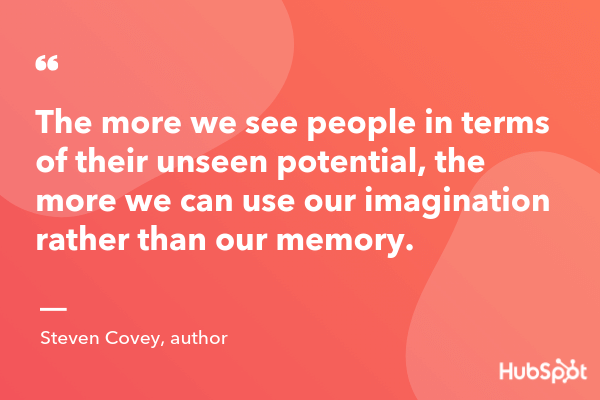
Renewal is the procedure that empowers united states of america to move along an upwards screw of growth and change, of continuous improvement.
Key Lessons:
1. Brand a list of activities that would help you renew yourself along each of the 4 dimensions. Select one activity for each dimension and list information technology as a goal for the coming week. At the end of the week, evaluate your operation. What led you to succeed or fail to accomplish each goal?
2. Commit to writing down a specific "acuminate the saw" activity in all four dimensions every calendar week, to do them, and to evaluate your functioning and results.


Originally published April xi, 2022 viii:00:00 AM, updated April 11 2022
Source: https://blog.hubspot.com/sales/habits-of-highly-effective-people-summary
0 Response to "7 Habits of Highly Effective People Negative Review"
Post a Comment